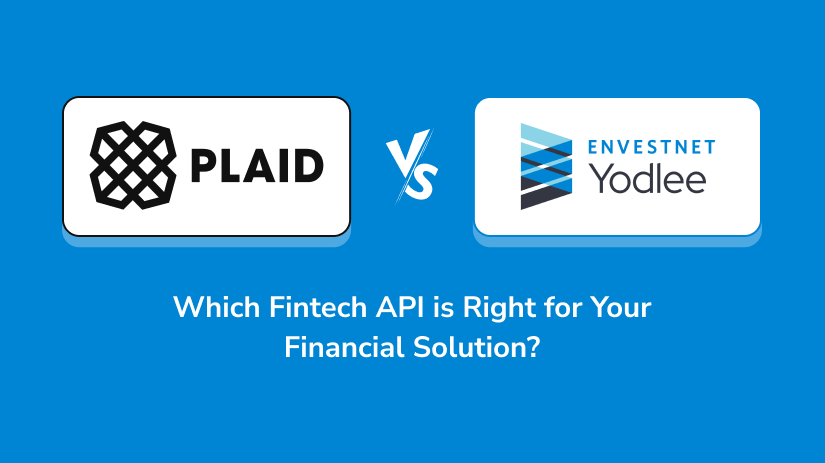In a world where the financial technology (fintech) landscape is evolving rapidly, the selection of fintech API providers matters to the success of your financial solution.
On the multiple options, there are two prominent players Plaid and Yodlee which provide fintech APIs. Both providers offer robust APIs that allow developers to access financial data and information and perform innovative financial mobile app development.
In this blog, we’ll compare Plaid and Yodlee API in simple words to help you find out which fintech integration is the right choice for your financial development.
Let’s Begin!!
Plaid: An Overview
Plaid Integration Services
Plaid offers a range of APIs that facilitate financial data integration into financial applications. The Plaid integration services include account authentication, transaction categorization, balance checks, and more.
Plaid Features
Plaid’s features include support for multiple financial institutions, real-time transaction data, webhook notifications, and developer-friendly documentation.
Pros and Cons
Pros
- Easy integration
- Comprehensive documentation
- Wide support for financial institutions
Cons
- Limited international coverage
- Pricing can be high for large-scale usage
Connect with us for Fintech Development Needs
Trusted by companies like Plaid, Yodlee, Codat.
Yodlee: An Overview
Yodlee Integration Services
Yodlee offers APIs that seamlessly access financial data, providing similar services to Plaid. The Yodlee integration services include account aggregation, transaction categorization, and identity verification.
Yodlee Features
Yodlee offers a bunch of features such as data enrichment, risk assessment, and predictive analytics to help financial businesses gain detailed insights into their customers’ financial behaviors.
Pros and cons
Pros
- Extensive international coverage
- Advanced analytics capabilities
- Established reputation in the industry
Cons
- Complex integration process
- Higher costs compared to some competitors
Connect with us for Fintech Development Needs
Trusted by companies like Plaid, Yodlee, Codat.
Comparison between Plaid vs Yodlee
When choosing between Plaid vs Yodlee, several factors should be considered:
Cost
Plaid typically provides a tiered pricing structure as per the usage, while Yodlee’s pricing structure may vary depending on the specific services required.
Ease of integration
Plaid is often adored for its straightforward integration process and developer-friendly documentation, whereas Yodlee’s integration may require a high level of technical expertise.
Security
Both Plaid and Yodlee prioritize security and implement crucial security measures such as encryption and tokenization to protect sensitive financial data.
Performance
Plaid is known for its fast and reliable performance, with real-time data updates and minimal response time. Yodlee also offers strong performance but may experience occasional delays during peak usage times.
Let’s see what are the main use cases of Plaid and Yodlee!!
Use cases for Plaid and Yodlee
Small businesses
Plaid may be a good choice for small businesses who want a simple and cost-effective financial solution, while Yodlee’s advanced analytics features and capabilities are suitable for larger enterprises.
Financial institutions
Both Plaid and Yodlee serve the requirements of financial institutions such as banking, lending, insurance, investment, payments, etc, offering APIs for account aggregation, risk assessment, and compliance monitoring.
Fintech startups
Fintech startups who want to prototype quickly and launch new products may get benefits from Plaid’s agile software development tools and extensive documentation.
Factors to consider when choosing between Plaid vs Yodlee
When evaluating Yodlee vs Plaid, consider factors such as scalability, compliance requirements, and customization options to ensure the chosen API aligns with your business objectives.
Final Words
In conclusion, both Plaid and Yodlee provide powerful fintech APIs for accessing financial data and building innovative fintech solutions.
The selection between the two ultimately depends on your business-specific requirements, budget, and long-term goals. Consider factors such as cost, ease of integration, security, and use case suitability when making your decision.
Happy Fintech API Integrations!!
Connect with us for Fintech Development Needs
Trusted by companies like Plaid, Yodlee, Codat.
Frequently Asked Questions (FAQs)
1. Are Plaid and Yodlee the only options for fintech APIs?
While Plaid and Yodlee are among the most well-known APU providers, there are other options available in the market, such as Tink, TrueLayer, and Finicity.
2. Can I use both Plaid and Yodlee in my application?
Yes, some fintech developers choose to integrate multiple APIs to leverage the strengths of each provider and enhance the functionality of their applications.
3. Is Plaid or Yodlee better for international use?
Yodlee tends to have broader international coverage compared to Plaid, making it a preferred choice for businesses operating in multiple countries.
4. How often do Plaid and Yodlee update their APIs?
Both Plaid and Yodlee regularly update their APIs to improve performance, add new features, and address security vulnerabilities.
5. Are there any regulatory considerations when using Plaid or Yodlee?
Yes, businesses must ensure compliance with relevant regulations, such as GDPR and PSD2, when integrating Plaid or Yodlee into their applications.





